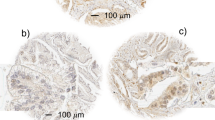Abstract
The human proto-oncogene INT2 (homologous to the mouse INT2 gene, implicated in proviral induced mammary carcinoma) has been mapped to chromosome 11q13 and found to share band localisation with, among others, the HST1 proto-oncogene. Both genes are members of the fibroblast growth factor family. In the present study, coamplification (2-15 copies) of the INT2/HST1 genes was found in 27 (9%) of 311 invasive human breast carcinomas using slot blot and Southern blot analyses. Amplification was not correlated to tumour size, axillary lymph node status or stage of disease, neither to patient age nor menopausal status. However, 26 (96%) of the 27 amplified tumours were, often strongly, Oestrogen receptor positive compared to 65% of the unamplified cases (P = 0.001). These findings are in sharp contrast to the strong correlations of HER-2/neu proto-oncogene amplification with advanced stage and steroid receptor negativity, previously observed in the same series of tumours. Patients with INT2/HST1 amplified breast cancer had a significantly shorter disease-free survival compared to those with unamplified genes (P = 0.015, median follow up 45 months). This correlation was confined to node-negative patients and persisted in multivariate analysis. No significant correlation to survival from breast cancer was found. It is concluded that amplification of the 11q13 region in breast cancer occurs in a particular subset of aggressive tumours, quite different from that identified by HER-2/neu amplification. It still remains to be shown that the selection for amplified genes at 11q13 is due to the activity of INT2, HST1 or yet another, still unidentified, neighbouring gene. However, the results are potentially of clinical value in separating a group of node-negative breast cancer for more intense treatment.
This is a preview of subscription content, access via your institution
Access options
Subscribe to this journal
Receive 24 print issues and online access
$259.00 per year
only $10.79 per issue
Buy this article
- Purchase on Springer Link
- Instant access to full article PDF
Prices may be subject to local taxes which are calculated during checkout
Similar content being viewed by others
Author information
Authors and Affiliations
Rights and permissions
About this article
Cite this article
Borg, Å., Sigurdsson, H., Clark, G. et al. Association of INT2/HST1 coamplification in primary breast cancer with hormone-dependent phenotype and poor prognosis. Br J Cancer 63, 136–142 (1991). https://doi.org/10.1038/bjc.1991.28
Issue Date:
DOI: https://doi.org/10.1038/bjc.1991.28
This article is cited by
-
No difference in CCND1 gene expression between breast cancer patients with and without lymph node metastasis in a Southern Brazilian sample
Clinical and Experimental Medicine (2016)
-
ANO1 amplification and expression in HNSCC with a high propensity for future distant metastasis and its functions in HNSCC cell lines
British Journal of Cancer (2010)
-
Gene products of chromosome 11q and their association with CCND1gene amplification and tamoxifen resistance in premenopausal breast cancer
Breast Cancer Research (2008)
-
Prognostic value of CCND1 gene status in sporadic breast tumours, as determined by real-time quantitative PCR assays
British Journal of Cancer (2002)
-
Identification of high-risk breast cancer patients from genetic changes of their tumors
Surgery Today (2000)



